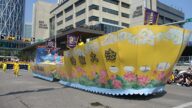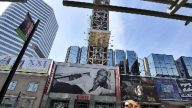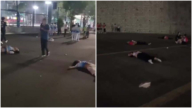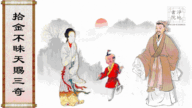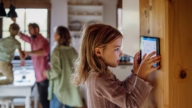【新唐人2012年6月24日讯】如何写电视记录片提案
企划与编剧是电视记录片的灵魂,参考一下吧~~
WRITING A BETTER ITVS TREATMENT
“If a story is in you, it has got to come out."
– William Faulkner
提案
In the treatment section of the ITVS proposal we ask you to communicate your passion and to explain how you envision translating your story from page to screen – taking into account structure, theme, style, format, voice and point-of-view. What do these words really mean? Here, members of the programming staff offer notes on writing an effective treatment. Remember, these are only suggestions; your treatment will undoubtedly be unique – tailored to the specific demands of your story.
关于电视记录片的提案,我们要求你传达你的热情,阐释你如何构思把一个书面的故事转化到屏幕上——考虑结构、主题、风格、形式、语态以及观点。这些究竟包 含什么样的内容呢?在此,节目制作人就如何写一个有效的文案提供了一些建议。记住,这些只是一些建议﹔你自己的文案毫无疑问才是唯一最适合于你的故事的表 达。
PASSION
When writing the treatment, don’t be afraid to infuse your words with passion. Your excitement and sense of urgency should be contagious.
热情
当你写提案时,不要担心把你的热情注入你的文字。你的兴奋和紧迫感应当是具有感染力的。
STRUCTURE
Like the frame of a house, or a human skeleton, structure holds up all the parts of a story, supporting and organizing the elements into a coherent and interrelated dramatic whole. Structure determines how the story will unfold dramatically, how it will build – moving through moments of tension and conflict – from beginning to middle to end. Structure is the road a reader takes through the dramatic terrain of the program.
结构
就像一座房子有框架,一个人有骨架一样,电视记录片也要有一个结构,来支持故事的所有部分,也就是把各个元素组织结构到一个连贯的有机的戏剧整体当中。结 构决定了故事的展开方式,以及从开头、发展到结局的建构方式——如何通过张力和冲突来推进故事的发展。结构是给读者的一条路,通过这条路,读者可以了解节 目的剧本结构。
One obvious structural framework is chronology – for example, following a character through an event in their life from start, through transformative changes, to finish. But there are as many possible structures as there are stories. The key is to find the one that fits, so that the reader/viewer is drawn in, compelled to stay, to discover the outcome. If you don’t know the outcome of your story, you can help the person evaluating your treatment by speculating a little, spelling out possible twists, turns and endings. Tell us what the overall story is, what happens in the course of a half hour or an hour, what we will have learned by the end that we didn’t know at the beginning. Try describing a key dramatic moment in detail, and locate it in the context of the whole story, so we get a sense of the program’s emotional trajectory.
一个最常见的结构线索就是以时间为序——例如,通过生活中发生的一件事的开始、演变,到结束,组织文章。但是,也有许多像故事一样的结构。关键是要找到一 种适合的方式,可以让读者/观众被吸引,被迫停下来,来寻找结果。如果你不知道故事的结果,你可以通过一些假设,通过揭示可能的纠结、转变和结局来帮助这 个人被你的文案吸引,进行评判。告诉我们整个故事是什么,在半个小时或者一个小时的时间里,发生了什么,我们会从结局中了解到什么,这个结局我们一开始并 不知道。尽量通过细节来描述关键的戏剧性时刻,把它放在整个故事的背景当中,这样,我们可以感受到这个节目的情绪轨迹。
THEME
Theme is what your story is really about – the underlying point your story is making. While your program tells a specific story rooted in a particular time and place, it no doubt addresses an overarching societal issue or universal human concern. Like a cell’s DNA, this theme should be embedded in every scene of your show, keeping it focused and on track.
主题
主题就是你的故事实际要表达的是什么——你的故事的根本点(the underlying point).当你的节目讲述一个植根于具体的时间和地点的故事时,它无疑表达了一个包罗万象的社会问题或者全人类共同关注的问题。就像细胞里的DNA,主题应当被植入到片子的每一个场景当中,使得人们关注这个事件,以及发展的轨迹。
STYLE
Style refers to a variety of tools one can mobilize to give the story a distinctive quality, feel, look or tone. Style can be articulated through camera work, editing, sound design, score, lighting, production design, interviewing technique, etc. Every stylistic choice becomes a signifier, telling the viewer something important about the story.
风格
风格指的是一个人可以动用的各种手段花样,目的是让故事呈现出与众不同的特性、感受、外貌或者品质。风格可通过摄像、剪辑、音效、配乐、灯光、美工、采访等手段来共同建构。每一种风格的选择变成一种标识,告诉观众关于这个故事的重要部分。
We encourage you to be specific when describing why and how you will engage stylistic tools. For example, what framing, composition, lighting or camera angle choices best serve the story? What editing strategies will accomplish the desired pace and rhythm? What kind of sound effects and score will you employ? Where will interviews take place and what interviewing method is most appropriate? If you are working with actors, what directing style will you use? What is your vision for the production design? If you are relying on still photographs or archival footage, how will you integrate them into the narrative? Use concrete examples to explain how style will illuminate the subject matter and theme. Be economical and deliberate.
当描述你为什么和怎样使用风格化的手段时,我们主张你说得更具体些。例如,取什么样的景,什么音乐,什么样的光或者镜头角度如何选择可以更好地表达故事? 什么样的剪辑方案可以完成你预期的节奏?你种被采用哪种音响效果和配乐?应该在哪儿采访,用什么样的采访方式最合适?如果你起用了演员,那你要用什么样的 导演风格?你对美工的视觉要求是什么?如果你打算使用一些照片或者资料影片,你打算把它们如何组织到你的叙事当中?使用具体的例子来解释风格如何阐释节目 的主旨和主题。要简洁而深刻。
Reading the treatment, we should be able to visualize your program and get a sense of how it will make us feel as we watch.
阅读提案时,我们就应该可以把你的节目视觉化,感到好像我们正在观看。
FORMAT: LENGTH AND SHOOTING FORMAT
To conform to standard public television broadcast lengths, your program must be either 26:40 or 56:40 minutes. Make it clear why the story is best told in either the half-hour or one-hour format.
Regarding the shooting format, explain why a particular format – for example, 16mm, digital video or beta – facilitates the stylistic and structural demands of the piece.
格式:长度和拍摄格式
为了达到公视节目的标准,节目的长度一般要么是半个小时,要么是一个小时。要很清楚为什么这个故事应当用半个小时讲或者一个小时讲。
根据拍摄的格式,解释为什么采用具体的格式——例如,16mm, DV 或者 Beta——更容易实现这个节目的风格和结构需求。
VOICE AND POINT-OF-VIEW
“Voice" can be a many-layered thing. When considering voice, we have to ask, Who is the storyteller and whose story is being told? The answers to these questions determine not only the viewer’s sense of intimacy with the characters, but the program’s point-of-view. In a truly personal story, the teller and subject are one and the same. When a maker represents another character or community, it is useful to be conscious of the ways storytelling can mediate the voice of the subject or main character.
语态和观点
语态可能是一个多层面的东西。当考虑语态时,我们必须要问,谁是故事的讲述者,讲的是谁的故事?对于这个问题的回答不仅仅决定了观众和人物之间的亲密感, 而且也决定了节目的观点。在一个真实的个人的故事当中,讲故事的人和被拍摄者是同一个人。当拍摄人员代表另一个人或者社会团体出现时,这是非常有用的,意 识到这种讲故事的方式可以调和第一人称或者主要人物的语态。
SYNOPSIS AS DISTINCT FROM TREATMENT
Like a thumbnail sketch or abstract, a synopsis is a condensed statement outlining the subject of the program and the story the program will tell. The synopsis might also briefly summarize the background of the program, that is, the larger context out of which the story emerged. Save the specific description – how you plan to tell this story – for the treatment.
提案清晰的大纲
大纲是对节目的主要内容或者故事的浓缩提炼。大纲也可以对节目的背景做简要的总结,也就是说,故事所发生的大环境。对于提案来说,就是把你打算如何讲这个故事的具体描述省去。
文章来源:
http://likechen.blogbus.com/logs/45059584.html




